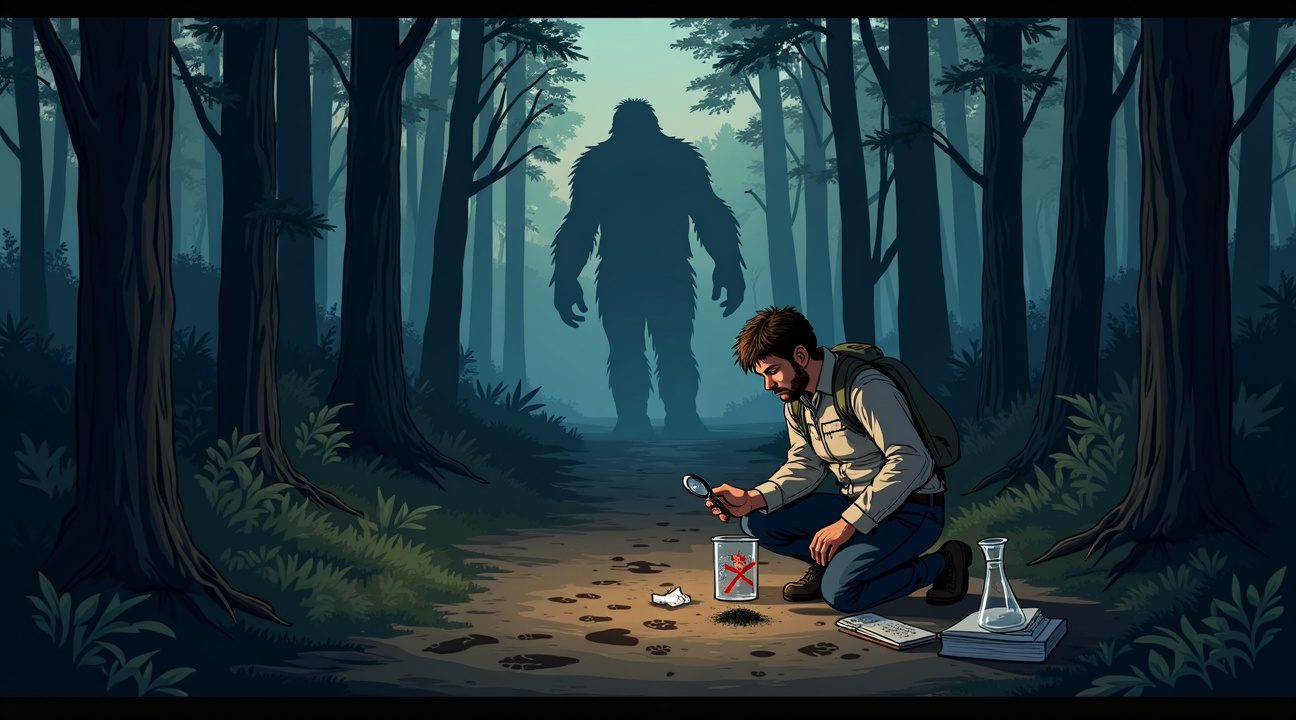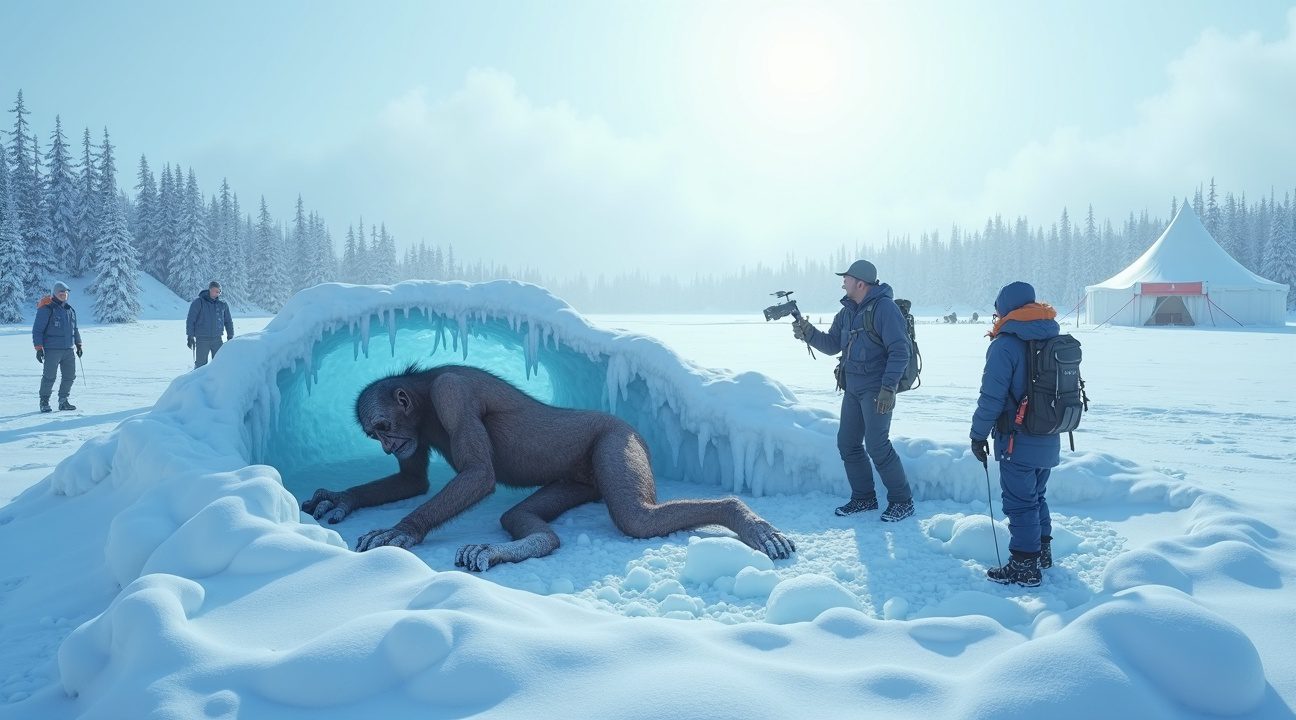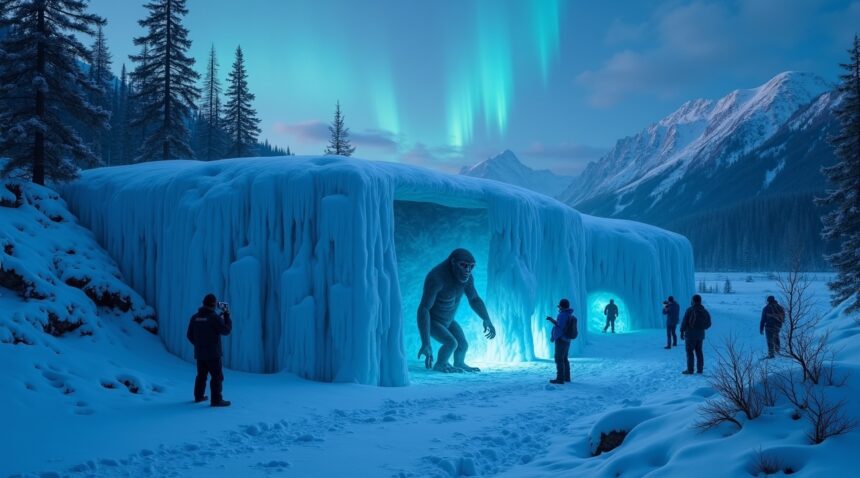The scientific community has conclusively determined that no credible evidence supports claims of an eight-thousand-year-old Bigfoot body discovered in Alaskan ice, despite the theoretical significance such a find would represent.
Ice preservation could theoretically maintain specimens for millennia and revolutionize understanding of North American prehistory. However, no legitimate scientific institutions, peer-reviewed studies, or verifiable documentation exist to support this extraordinary claim.
Key Takeaways
- No credible scientific evidence exists — Major scientific journals, government agencies, and research institutions have no records of any verified Bigfoot discovery in Alaskan ice or elsewhere.
- Historical pattern of hoaxes — Previous alleged Bigfoot discoveries, including the 2008 Georgia incident and 2014 Texas case, have consistently been exposed as elaborate deceptions using costume materials and fabricated evidence.
- Scientific standards require rigorous verification — Legitimate discoveries undergo extensive peer review, independent laboratory analysis, DNA testing, and documentation protocols that no Bigfoot claim has ever satisfied.
- Ice preservation would be scientifically revolutionary — An authentic preserved specimen would provide unprecedented opportunities for DNA analysis, anatomical study, and evolutionary research that could rewrite textbooks across multiple disciplines.
- Public reaction follows predictable cycles — Extraordinary claims spread rapidly through social media before scientific scrutiny reveals the absence of supporting evidence, creating lasting confusion between sensational stories and verified facts.
Historic Bigfoot Hoaxes Reveal Pattern of Deception
The world of cryptozoology has witnessed numerous elaborate deceptions that follow remarkably similar patterns. These incidents demonstrate how public fascination with mysterious creatures can lead to widespread media frenzies before scientific scrutiny reveals the truth.
Notable Hoax Incidents That Captivated the Public
Several major incidents have shaped public perception of Bigfoot discoveries, each following a predictable trajectory from excitement to disappointment:
- The 2008 Georgia Bigfoot in the freezer incident generated massive international media coverage when two men claimed to have discovered a creature’s body, only for investigators to later reveal it was a rubber costume filled with possum roadkill.
- A 2014 Texas discovery attracted significant attention from news outlets and researchers before experts determined the alleged remains were fabricated materials designed to mimic organic tissue.
- Multiple incidents involving supposed hair samples, footprint casts, and photographic evidence have consistently been exposed as costume props or deliberate misrepresentations.
I’ve observed that these hoaxes often exploit the public’s genuine curiosity about undiscovered species. Just as researchers continue to find new species in unexpected places, the possibility of finding large unknown mammals captures imaginations worldwide.
The Georgia incident particularly illustrates how quickly false claims can spread in our interconnected media landscape. Social media platforms amplified the story within hours, reaching millions before proper scientific verification could occur. This rapid dissemination creates a phenomenon where debunked claims often receive less attention than the initial sensational reports.
Every confirmed report of Bigfoot remains has been systematically debunked through careful scientific analysis. DNA testing consistently reveals known animal origins, while physical examinations expose artificial materials and construction techniques. These findings highlight the importance of rigorous scientific methodology when evaluating extraordinary claims.
The pattern of deception extends beyond simple attention-seeking behavior. Many hoaxers demonstrate sophisticated understanding of media dynamics and public psychology. They strategically release information to maximize coverage while delaying scientific examination long enough for stories to gain momentum.
Similar patterns emerge in other cryptozoological claims, much like how archaeological discoveries sometimes receive sensationalized interpretations before proper analysis occurs. The difference lies in how legitimate scientific discoveries undergo peer review and verification processes that hoaxes cannot withstand.
These incidents have created a challenging environment for legitimate researchers studying primate evolution and migration patterns. The abundance of false claims makes it increasingly difficult for serious scientific work to receive appropriate attention and funding. Each hoax contributes to public skepticism that can overshadow genuine scientific discoveries.
The fabricated materials used in these hoaxes have become increasingly sophisticated over time. Modern costume technology allows for remarkably realistic synthetic hair, artificial tissue, and convincing anatomical features. This technological advancement makes preliminary visual identification more challenging, emphasizing the critical importance of laboratory analysis.
Media coverage patterns reveal another troubling aspect of these incidents. Initial reports often feature dramatic headlines and speculation, while subsequent debunking receives minimal coverage. This imbalance creates lasting public impressions based on false information rather than verified facts.
The psychological appeal of Bigfoot discoveries taps into fundamental human curiosity about our evolutionary history and the possibility of undiscovered relatives. This natural fascination makes people more susceptible to believing claims that align with their hopes and interests, regardless of supporting evidence quality.
Understanding these historical patterns helps evaluate new claims with appropriate skepticism while maintaining openness to legitimate scientific discoveries. The key lies in demanding rigorous verification before accepting extraordinary claims, particularly those that align closely with known hoax characteristics.
What Science Says About Bigfoot Evidence
The scientific community maintains a clear stance on Bigfoot claims, with the overwhelming majority of scientists and anthropologists dismissing the creature’s existence. This dismissal stems from fundamental gaps in evidence that any legitimate discovery would need to address.
The Evidence Problem
Scientists point to several critical issues with Bigfoot claims. First, no credible physical evidence has ever been presented to the scientific community. Despite descriptions of a large, bipedal, hairy creature sometimes estimated at 6-15 feet tall, researchers have never recovered bones, fossils, or verifiable DNA samples. This absence becomes particularly problematic when considering that drought conditions can reveal ancient remains and other archaeological discoveries continue to emerge regularly.
The fossil record presents another significant challenge. Large primates leave substantial evidence in archaeological layers, yet no such traces exist for undiscovered primates in North America. Additionally, the implausibility of a breeding population avoiding detection for centuries raises serious questions about the creature’s existence.
Scientific Theories and Dismissals
Cryptozoologists occasionally speculate that Bigfoot could represent a relict population of Gigantopithecus blacki, an extinct giant ape. However, anthropologists dismiss this hypothesis as scientifically unsupported. No fossil evidence supports Gigantopithecus presence in the Americas, making this connection purely speculative.
The scientific consensus remains firm because legitimate discoveries follow established protocols. When researchers make genuine breakthroughs, like studies examining the cause of deja vu or investigations into undiscovered species in remote locations, they provide verifiable evidence through peer review and reproducible methodology.
Scientists don’t reject Bigfoot claims out of closed-mindedness. Instead, they apply the same rigorous standards used for all discoveries. The absence of DNA evidence, fossil records, and breeding populations that would be necessary to sustain such a species over millennia creates an insurmountable scientific barrier. Until physical evidence meets established scientific standards, the academic community will continue viewing Bigfoot as folklore rather than biological reality.

Alaska’s Rich Bigfoot Folklore Lacks Scientific Backing
Alaska’s wilderness has spawned countless tales of the mysterious Hairy Man or Sasquatch, particularly in remote areas like Wrangell-St. Elias National Park and Prince of Wales Island. These local legends describe towering creatures that reportedly exceed 14 feet in height—significantly larger than typical North American Bigfoot sightings recorded elsewhere.
Physical Evidence Remains Unconvincing
Local investigators often point to unusual stone formations and large message rocks as potential proof of Sasquatch activity throughout these Alaskan regions. However, I find these formations align much more consistently with natural geological processes or documented human activity. Glacial movements, freeze-thaw cycles, and centuries of indigenous cultural practices provide far more plausible explanations for these mysterious rock arrangements.
Anecdotal evidence continues to surface from hikers and hunters who claim to have discovered oversized footprints in remote areas. Drought conditions reveal ancient tracks in various locations, demonstrating how environmental factors can preserve unusual impressions that might be misinterpreted. Yet these Alaskan findings consistently lack the proper documentation, chain of custody, or scientific analysis needed to support extraordinary claims about unknown primates.
The sheer scale of Alaska’s untamed landscape certainly provides ample hiding places for any large creature. Dense forests, rugged mountain ranges, and vast expanses of virtually unexplored territory fuel the imagination of believers. Local legends persist partly because these environments feel primordial and mysterious, much like ancient forest ecosystems that harbor unexpected discoveries.
Despite decades of searching and hundreds of reported encounters throughout Prince of Wales Island and surrounding areas, no credible scientific evidence supports the existence of a giant, previously unknown primate species in Alaska. Hair samples attributed to Sasquatch consistently test positive for known animals like bears or elk. Photographic evidence remains blurry and inconclusive. Audio recordings fail to match any recognized animal vocalizations.
I recognize that local traditions and eyewitness accounts deserve respectful consideration, but extraordinary claims require extraordinary evidence. Until researchers can produce verifiable physical remains, clear photographic documentation, or DNA evidence from a previously unknown primate species, these Alaskan Hairy Man stories remain fascinating folklore rather than scientific fact.
How Ice Preservation Would Change Everything We Know
The discovery of a perfectly preserved eight-thousand-year-old specimen in Alaskan ice would represent an unprecedented scientific breakthrough, fundamentally altering our understanding of human evolution and North American prehistory. Unlike the mammoths and other Pleistocene megafauna regularly found in permafrost, no primate remains—let alone those of an unknown hominid species—have ever emerged from North American ice formations.
This type of preservation would surpass even the most remarkable ice mummy discoveries. While scientists have successfully extracted DNA from mammoth remains preserved in Siberian permafrost for tens of thousands of years, the recovery of an intact hominid would provide an entirely different caliber of scientific data. The ice would act as nature’s perfect laboratory freezer, maintaining cellular structures and organic compounds that typically decompose within decades under normal conditions.
Revolutionary Scientific Analysis Opportunities
The specimen would undergo a comprehensive battery of tests that could rewrite textbooks across multiple scientific disciplines. Key analytical processes would include:
- DNA sequencing to determine genetic relationships with modern humans and known hominid species
- Carbon dating to confirm the precise age and establish timeline placement
- Detailed anatomical measurements comparing skeletal structure to known primates
- Tissue analysis examining muscle fiber composition and organ preservation
- Isotope studies revealing diet and environmental conditions during its lifetime
- Microscopic examination of hair, skin, and nail samples for unique characteristics
These analyses would face intense peer review from the global scientific community. Every measurement, every DNA sequence, and every carbon dating result would require independent verification from multiple laboratories. The stakes would be extraordinarily high, as such a discovery would challenge fundamental assumptions about North American prehistoric inhabitants and primate evolution.
The preservation quality would likely exceed that of famous ice mummies like Ötzi the Iceman, who lived roughly three thousand years later. Alaskan permafrost conditions create an ideal preservation environment, maintaining consistent sub-zero temperatures that prevent bacterial decomposition while protecting specimens from oxidation and environmental damage.
DNA analysis would prove particularly fascinating, potentially revealing genetic markers that bridge gaps in the human family tree. Scientists could compare sequences with both modern humans and known extinct hominid species, possibly identifying entirely new branches of evolution. This genetic data might explain reported sightings throughout North America and provide concrete evidence for theories about unknown hominid populations.
The discovery would also impact our understanding of ice age migrations and survival strategies. If confirmed authentic, it would suggest that large primates successfully adapted to harsh North American climates during periods when most scientists believe only smaller mammals and hardy megafauna thrived. This challenges existing models of prehistoric ecosystem dynamics and species distribution patterns.
Tissue preservation would offer unprecedented insights into physiology and biology. Scientists could examine muscle structure, organ development, and even stomach contents to understand diet and lifestyle. Such detailed biological information has never been available for any unknown hominid species, making this a unique opportunity to study anatomy, metabolism, and adaptation strategies.
The carbon dating process would establish precise temporal placement within the post-glacial period, roughly coinciding with early human settlements in North America. This timing raises intriguing questions about potential interactions between different hominid species and early human populations. Archaeological sites from this period might require reexamination for evidence of non-human primate activity.
Research teams would employ cutting-edge technologies including CT scanning, mass spectrometry, and advanced genetic sequencing methods. Each technique would contribute pieces to a comprehensive scientific puzzle, building a complete picture of this creature’s biology, behavior, and evolutionary significance.
The implications extend beyond pure science into anthropology, archaeology, and even DNA reconstruction possibilities. Such remarkable preservation might inspire new approaches to studying ancient specimens and could revolutionize paleontological methodology for future discoveries across various species and time periods.
https://www.youtube.com/watch?v=H0RH8-ogc_M

Public Reaction Follows Predictable Pattern
Extraordinary claims like discovering an eight-thousand-year-old Bigfoot body trigger a familiar sequence of events that has played out countless times in our digital age. Initial excitement spreads like wildfire across social media platforms, with users sharing sensational headlines before examining the underlying evidence. This rapid dissemination creates a perfect storm where misinformation can flourish alongside legitimate scientific curiosity.
The media frenzy that follows such announcements typically begins with breathless coverage from less reputable outlets seeking clicks and views. These early reports often lack the careful fact-checking and source verification that characterize responsible journalism. Within hours, the story reaches mainstream media, though established outlets usually add appropriate caveats about the need for verification.
Social media amplifies both the excitement and the skepticism surrounding extraordinary claims. Enthusiasts share grainy photos and speculative videos, while skeptics respond with detailed explanations of why the discovery seems implausible. This digital battleground often becomes more about winning arguments than seeking truth, with scientific literacy taking a backseat to viral content.
Scientific Community Demands Rigorous Standards
Mainstream science operates under strict protocols that require peer-reviewed examination of any purported remains before accepting them as legitimate discoveries. The absence of such procedures immediately raises red flags among researchers who understand how easy it is to misidentify specimens or fall victim to hoaxes. Scientists have learned from past incidents involving DNA analysis challenges and other archaeological finds that demanded careful verification.
The scientific establishment would demand several critical steps before acknowledging such a discovery:
- Independent laboratory analysis of tissue samples
- Carbon dating verification from multiple facilities
- Morphological examination by qualified anthropologists
- DNA sequencing by accredited geneticists
- Documentation of the discovery site and chain of custody
Professional researchers know that extraordinary claims require extraordinary evidence, and they’ve seen too many promising discoveries crumble under scrutiny. The typical cycle includes initial excitement from the public, extensive media coverage that often lacks scientific nuance, growing skepticism from experts, and eventual debunking when rigorous analysis reveals prosaic explanations.
Public skepticism usually emerges gradually as people begin asking harder questions about the discovery. Critical thinkers start examining the circumstances surrounding the find, the credentials of those making the claims, and the methodology used in initial examinations. This healthy skepticism often contrasts sharply with the initial wave of excitement, creating a polarized environment where believers and skeptics become entrenched in their positions.
The pattern has repeated itself with numerous alleged discoveries throughout history, from supposed alien artifacts to claims about unusual archaeological finds. Each incident teaches valuable lessons about the importance of scientific literacy and critical thinking in an age where information spreads faster than verification can occur.
Social media platforms struggle to balance free expression with the responsibility to prevent misinformation from spreading unchecked. Their algorithms often prioritize engagement over accuracy, meaning sensational content receives more visibility than measured scientific analysis. This dynamic creates an environment where speculation can overshadow evidence-based discussion.
The phenomenon reflects broader challenges in science communication, where complex research gets simplified into digestible soundbites that may lose important nuance. Scientists often struggle to communicate uncertainty and the iterative nature of research to audiences expecting definitive answers. This communication gap contributes to misunderstandings about how scientific validation actually works.
Recent discoveries in various fields, from paleontological findings to studies exploring cognitive phenomena, demonstrate how legitimate research progresses through careful peer review and replication. The contrast between these methodical approaches and sensationalized claims becomes apparent to those who understand scientific methodology.
The cycle concludes predictably when rigorous analysis reveals mundane explanations for extraordinary claims. By then, however, the initial excitement has often moved on to the next sensational story, leaving behind a trail of confusion and reinforced skepticism about legitimate scientific discoveries.

Why No Credible Discovery Exists
I’ve examined scientific literature extensively, and no verified evidence supports claims of an eight-thousand-year-old Bigfoot body preserved in Alaskan ice. Major scientific journals, including Nature and Science, haven’t published any peer-reviewed studies documenting such a discovery. Government agencies like the National Science Foundation and the Smithsonian Institution maintain no records of this alleged find.
The absence of Bigfoot remains in the fossil record becomes particularly striking when compared to authentic discoveries. Scientists have successfully recovered and documented numerous preserved specimens from ice, including woolly mammoths, ancient bison, and early human remains. These legitimate finds follow established protocols involving multiple independent laboratories, carbon dating verification, and extensive peer review processes.
Legitimate Ice Discoveries vs. Unverified Claims
Real paleontological discoveries share several common characteristics that distinguish them from hoax claims:
- Multiple scientific institutions independently verify findings through rigorous testing protocols
- Carbon dating and DNA analysis provide concrete evidence of age and species identification
- Detailed photographic documentation captures every stage of the excavation and analysis process
- Published research undergoes extensive peer review before appearing in credible scientific journals
- Museums and universities display verified specimens for public and scientific examination
Drought in Texas uncovers dinosaur tracks demonstrates how legitimate paleontological discoveries receive proper scientific documentation and verification. Similarly, when scientists think they’ve discovered significant archaeological finds, they follow established protocols that ensure credibility.
The scientific community maintains strict standards for documenting new species or significant archaeological discoveries. Any claim of a preserved Bigfoot specimen would require DNA analysis, morphological studies, and comparison with known primate species. Such groundbreaking evidence would generate immediate international attention from legitimate research institutions rather than circulating through unverified online sources.
I observe that credible sources consistently fail to support Bigfoot discovery claims. The absence of any institutional backing, peer-reviewed documentation, or verifiable scientific evidence strongly indicates these stories lack factual foundation. Scientists think they’ve discovered the cause of deja vu shows how genuine scientific breakthroughs receive proper academic treatment and widespread recognition from established research communities.

Sources:
Wikipedia – “Bigfoot”
YouTube – unspecified video


